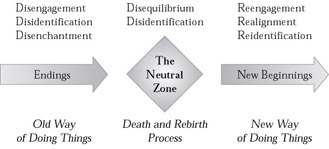Rejoining the Corporation
Leaders who have never been through this process before tend to underestimate its impact. Though you may grasp how the company will change quantitatively—fewer people, a new mix of resources, a different brand—you may not realize the psychological impact it will have on you. If you’re an ambitious leader who has set a career path for yourself within an organization, you’re going to be shocked to discover that this path no longer exists.
All the great performance reviews you’ve enjoyed, all the goals you’ve reached, all the connections you’ve made, all the promises that have been made to you—an acquisition or merger can invalidate these achievements and commitments. Psychologically, this can be difficult to deal with. It’s even more difficult if the company that acquires you is a competitor, as is often the case. For a number of years, you’ve viewed the acquiring company as the enemy; you’ve made it a point to emphasize your strengths versus their weaknesses in internal and external communications. Now you are being asked to embrace their products, services, policies, and culture.
In addition, a merger or acquisition doesn’t happen overnight. You’re going to feel the impact for months, starting with the first rumor that the merger will take place. Many times, companies talk about how quickly and smoothly their merger went, boasting that it was completed in twenty-seven days. It may be that the legal process took twenty-seven days or that this was the amount of time needed to evaluate and reduce staff and other redundant operations. But in reality, the cultural adaptation process takes much longer. Phase I of a merger or acquisition is where everyone’s time, energy, and focus go. This phase is when all the contractual and financial issues are addressed and decisions are made regarding people and operations. Phase II, however, is frequently overlooked. This is when the two cultures are brought together, when the hearts-and-minds issues are addressed. Leaders are suddenly forced into what William Bridges has termed “the neutral zone,” that is, where a former identity, role, or self-concept ends and they are still undecided whether to fully commit to the new organization, enabling the formulation of a new identity. The place between these two events is confusing, emotional, and characterized by emotional highs and lows. Some people move quickly through the neutral zone (see Figure 10.1); others inhabit it for weeks, months, and occasionally years.

Figure 10.1: The Neutral Zone.
Source: Bridges, 1980.
This is very difficult to do if you haven’t grieved the loss of the old company, and most organizations don’t provide for a grieving process; most individuals don’t recognize the need to let go on their own. As a result, you may offer your new bosses a verbal buy-in, but secretly you still view them as “they” and the old corporate entity as “we.” When GE acquired RCA, they had RCA’s leaders visit the GE training facility at Crotonville. When the RCA people arrived, GE executives presented them with GE T-shirts. The next day, the RCA group brought in boxes of RCA T-shirts for GE leaders. Although the RCA leaders may have made this gesture with the best of intentions, they were missing the point: things had changed; RCA was not an equal. Acquiring companies want to know that their new people are on the team. Too frequently, however, acquired leaders see their role differently. They want to add value and believe they can do so by pointing out the flaws in the acquirer’s system, referring to their old system as a way to help them correct these flaws.
Exhibit 10.1 shows typical emotional responses to a merger; the responses progress through stages.
| Denial | “It won’t happen.” |
| Fear | “What will happen to me?” |
| Anger | “We’ve been sold out!” |
| Sadness | “Things used to be so much better.” |
| Acceptance | “I guess we have no choice.” |
| Relief | “This looks better than I thought at first.” |
| Interest | “Maybe there are possibilities.” |
| Liking | “I really feel comfortable now.” |
| Enjoyment | “This could be great!” |
Despite the best intentions on both sides, the offer to critique, change, or refer to former best practices is often not appreciated by the acquirer. The reason is that mergers and acquisitions are emotional events handled in a rational fashion. The learning for leaders occurs in managing their own reactions, developing an objective view of the change process, and eventually recognizing that lack of commitment doesn’t make sense if you want to remain employed by the merged organization.
EAN: 2147483647
Pages: 121